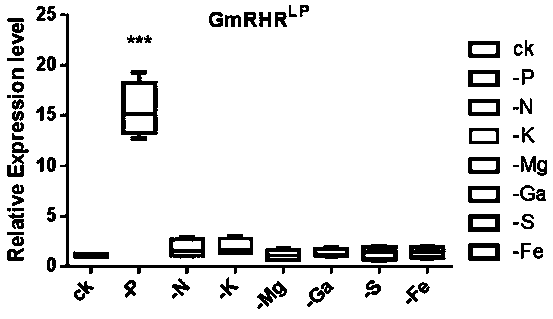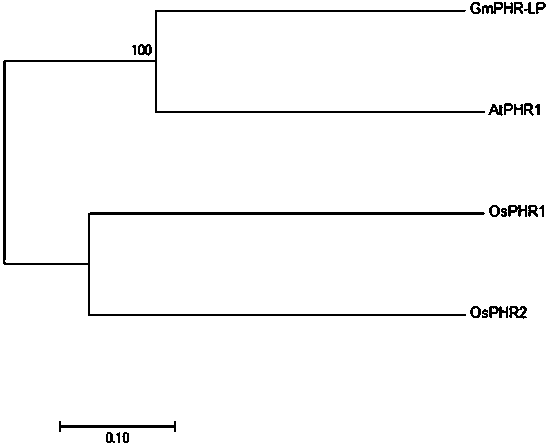Soybean specific response low-phosphorous transcription factor GmPHRLP and application
A transcription factor, specific response technology, applied in the application, genetic engineering, plant genetic improvement and other directions, can solve the problems of increasing plant phosphorus nutrient absorption, unable to adapt and respond to low phosphorus, and achieve the effect of increasing biomass and increasing absorption
- Summary
- Abstract
- Description
- Claims
- Application Information
AI Technical Summary
Problems solved by technology
Method used
Image
Examples
Embodiment 1
[0017] Example 1, Low Phosphorus Responsive Transcription Factors GPHR LP clone
[0018] 1) The 10-day-old seedlings of the phosphorus-efficient soybean variety "BX10" were subjected to low-phosphorus treatment (10µM) and normal culture as a control. The soybean root materials were taken for RNA-seq analysis, and the expression levels significantly changed under low phosphorus. Gene.
[0019] 2) Find a MYB-like transcription factor significantly induced by low phosphorus by analyzing RNA-seq data;
[0020] 3) According to the reference sequence provided by RNA-seq and phytozome, design specific primers, (primer sequence: GmPHR LP -F: ATGGAAGCACGTTCTGCTTTCTCTA; GmPHR LP -R: TTACTCCTCTGTCCTTGGACGCTTTGA ), using the root cDNA of phosphorus-efficient soybean variety "BX10" as a template for PCR amplification.
[0021] 4) Electrophoresis detection Amplified products were separated and detected by 1% agarose gel electrophoresis. The test results are attached figure 1 As show...
Embodiment 2
[0022] Example 2, low phosphorus response transcription factor GPHR LP Response to different nutrient deficiency treatments
[0023] In order to further investigate whether the low-phosphorus-responsive transcription factor obtained by this clone is a low-phosphorus-specific response transcription factor, we subjected the seedlings of the phosphorus-efficient soybean variety "BX10" to different deficiencies (-N, -P, -K, -Mg, -Ga, -Fe) treatment, the soybean roots were harvested, total RNA was extracted, and reverse transcribed into cDNA. qRT-PCR analysis was carried out with the specific quantitative PCR primers of this transcription factor (primer sequence GmPHR LP -qPCR-F: GCATTGGAAGTGGGTGAGAA; GmPHR LP -qPCR-R: TGGACGCTTTGAGGCTT TAG), it was found that the transcription factor only responded to phosphorus deficiency, but did not change significantly to other deficiency treatments (attached figure 2 ), it is speculated that this gene is mainly involved in the low phosph...
Embodiment 3
[0024] Embodiment 3, bioinformatics analysis The GPHR LP transcription factor
[0025] In order to further analyze which family of transcription factors this low-phosphorus-specific response transcription factor belongs to and its evolutionary relationship with the central regulators of phosphorus-deficiency signaling in model plants that have been reported so far, we translated the ORF segment of the obtained DNA into BLAST analysis of protein sequences (https: / / blast.ncbi.nlm.nih.gov / Blast.cgi), found that most of the proteins homologous to this transcription factor belong to the MYB-CC class of transcription factors, so we selected The phylogenetic tree and protein similarity comparison of the homologous transcription factors of the reported model plants are shown in the attached image 3 As shown, this transcription factor has a high degree of similarity with AtPHR1 of Arabidopsis and OsRHR1 and OsPHR2 of rice, and belongs to homologous genes in evolution.
[0026] Exam...
PUM
 Login to View More
Login to View More Abstract
Description
Claims
Application Information
 Login to View More
Login to View More - R&D
- Intellectual Property
- Life Sciences
- Materials
- Tech Scout
- Unparalleled Data Quality
- Higher Quality Content
- 60% Fewer Hallucinations
Browse by: Latest US Patents, China's latest patents, Technical Efficacy Thesaurus, Application Domain, Technology Topic, Popular Technical Reports.
© 2025 PatSnap. All rights reserved.Legal|Privacy policy|Modern Slavery Act Transparency Statement|Sitemap|About US| Contact US: help@patsnap.com



